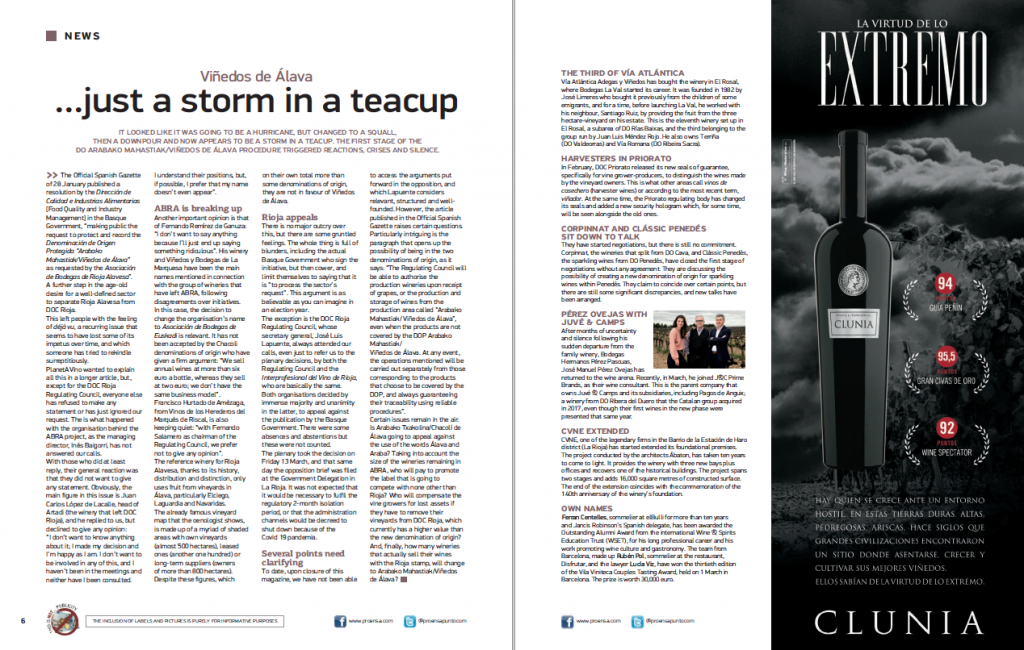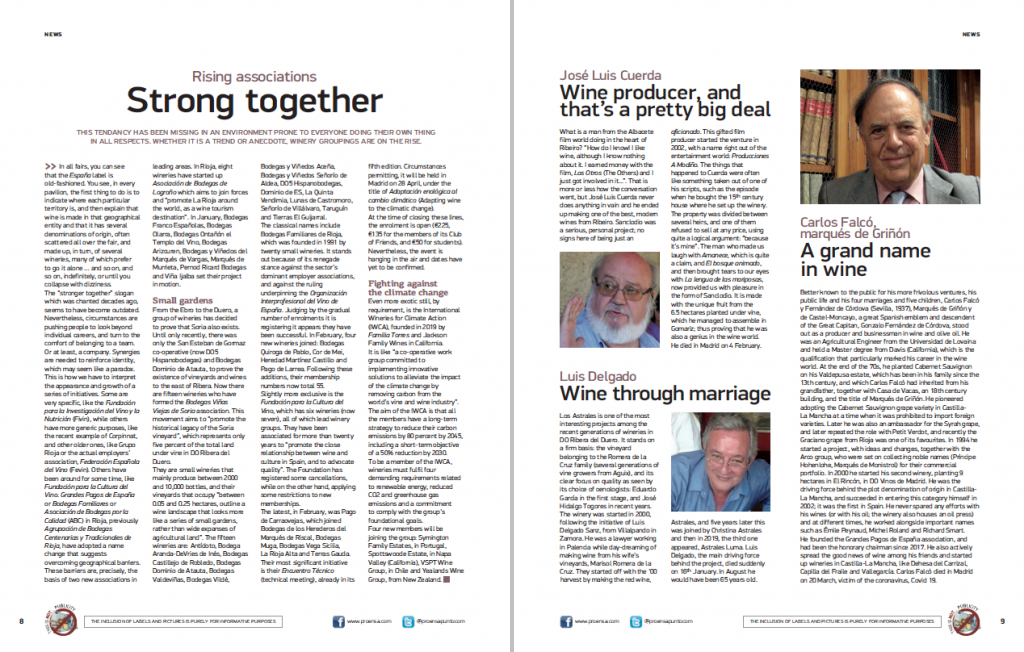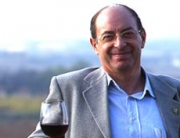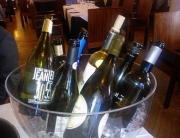Viñedos de Álava
…just a storm in a teacup
It looked like it was going to be a hurricane, but changed to a squall, then a downpour and now appears to be a storm in a teacup. The first stage of the DO Arabako Mahastiak/Viñedos de Álava procedure triggered reactions, crises and silence.
The Official Spanish Gazette of 28 January published a resolution by the Dirección de Calidad e Industrias Alimentarias [Food Quality and Industry Management] in the Basque Government, “making public the request to protect and record the Denominación de Origen Protegida “Arabako Mahastiak/Viñedos de Álava” as requested by the Asociación de Bodegas de Rioja Alavesa”. A further step in the age-old desire for a well-defined sector to separate Rioja Alavesa from DOC Rioja.
This left people with the feeling of déjà vu, a recurring issue that seems to have lost some of its impetus over time, and which someone has tried to rekindle surreptitiously.
PlanetAVino wanted to explain all this in a longer article, but, except for the DOC Rioja Regulating Council, everyone else has refused to make any statement or has just ignored our request. The is what happened with the organisation behind the ABRA project, as the managing director, Inés Baigorri, has not answered our calls.
With those who did at least reply, their general reaction was that they did not want to give any statement. Obviously, the main figure in this issue is Juan Carlos López de Lacalle, head of Artadi (the winery that left DOC Rioja), and he replied to us, but declined to give any opinion: “I don’t want to know anything about it; I made my decision and I’m happy as I am. I don’t want to be involved in any of this, and I haven’t been in the meetings and neither have I been consulted. I understand their positions, but, if possible, I prefer that my name doesn’t even appear”.
ABRA is breaking up
Another important opinion is that of Fernando Remírez de Ganuza: “I don’t want to say anything because I’ll just end up saying something ridiculous”. His winery and Viñedos y Bodegas de La Marquesa have been the main names mentioned in connection with the group of wineries that have left ABRA, following disagreements over initiatives.
In this case, the decision to change the organisation’s name to Asociación de Bodegas de Euskadi is relevant. It has not been accepted by the Chacoli denominations of origin who have given a firm argument: “We sell annual wines at more than six euro a bottle, whereas they sell at two euro; we don’t have the same business model”.
Francisco Hurtado de Amézaga, from Vinos de los Herederos del Marqués de Riscal, is also keeping quiet: “with Fernando Salamero as chairman of the Regulating Council, we prefer not to give any opinion”. The reference winery for Rioja Alavesa, thanks to its history, distribution and distinction, only uses fruit from vineyards in Álava, particularly Elciego, Laguardia and Navaridas.
The already famous vineyard map that the oenologist shows, is made up of a myriad of shaded areas with own vineyards (almost 500 hectares), leased ones (another one hundred) or long-term suppliers (owners of more than 800 hectares). Despite these figures, which on their own total more than some denominations of origin, they are not in favour of Viñedos de Álava.
Rioja appeals
There is no major outcry over this, but there are some gruntled feelings. The whole thing is full of blunders, including the actual Basque Government who sign the initiative, but then cower, and limit themselves to saying that it is “to process the sector’s request”. This argument is as believable as you can imagine in an election year.
The exception is the DOC Rioja Regulating Council, whose secretary general, José Luis Lapuente, always attended our calls, even just to refer us to the plenary decisions, by both the Regulating Council and the Interprofesional del Vino de Rioja, who are basically the same. Both organisations decided by immense majority and unanimity in the latter, to appeal against the publication by the Basque Government. There were some absences and abstentions but these were not counted.
The plenary took the decision on Friday 11 March, and that same day the opposition brief was filed at the Government Delegation in La Rioja. It was not expected that it would be necessary to fulfil the regulatory 2-month isolation period, or that the administration channels would be decreed to shut down because of the Covid 19 pandemia.
Several points need clarifying
To date, upon closure of this magazine, we have not been able to access the arguments put forward in the opposition, and which Lapuente considers relevant, structured and well-founded. However, the article published in the Official Spanish Gazette raises certain questions. Particularly intriguing is the paragraph that opens up the possibility of being in the two denominations of origin, as it says: “The Regulating Council will be able to authorise the production wineries upon receipt of grapes, or the production and storage of wines from the production area called “Arabako Mahastiak/ Viñedos de Álava”, even when the products are not covered by the DOP Arabako Mahastiak/
Viñedos de Álava. At any event, the operations mentioned will be carried out separately from those corresponding to the products that choose to be covered by the DOP, and always guaranteeing their traceability using reliable procedures.”
Certain issues remain in the air: Is Arabako Txakolina/Chacolí de Álava going to appeal against the use of the words Álava and Araba? Taking into account the size of the wineries remaining in ABRA, who will pay to promote the label that is going to compete with none other than Rioja? Who will compensate the vine growers for lost assets if they have to remove their vineyards from DOC Rioja, which currently has a higher value than the new denomination of origin? And, finally, how many wineries that actually sell their wines with the Rioja stamp, will change to Arabako Mahastiak/Viñedos de Álava?
José Luis Cuerda
Wine producer, and that’s a pretty big deal
What is a man from the Albacete film world doing in the heart of Ribeiro? “How do I know! I like wine, although I know nothing about it. I earned money with the film, Los Otros (The Others) and I just got involved in it…”. That is more or less how the conversation went, but José Luis Cuerda never does anything in vain and he ended up making one of the best, modern wines from Ribeiro. Sanclodio was a serious, personal project; no signs here of being just an aficionado. This gifted film producer started the venture in 2002, with a name right out of the entertainment world: Producciones A Modiño. The things that happened to Cuerda were often like something taken out of one of his scripts, such as the episode when he bought the 15th century house where he set up the winery. The property was divided between several heirs, and one of them refused to sell at any price, using quite a logical argument: “because it’s mine”. The man who made us laugh with Amanece, which is quite a claim, and El bosque animado, and then brought tears to our eyes with La lengua de las mariposas, now provided us with pleasure in the form of Sanclodio. It is made with the elegant, unique fruit from the 6.5 hectares planted under vine, which he managed to assemble in Gomariz; thus proving that he was also a genius in the wine world. He died in Madrid on 4 February.
Luis Delgado
Wine through marriage
Los Astrales is one of the most interesting projects among the recent generations of wineries in DO Ribera del Duero. It stands on a firm basis: the vineyard belonging to the Romera de la Cruz family (several generations of vine growers from Aguix), and its clear focus on quality as seen by its choice of oenologists: Eduardo García in the first stage, and José Hidalgo Togores in recent years. The winery was started in 2000, following the initiative of Luis Delgado Sanz, from Villalpando in Zamora. He was a lawyer working in Palencia while day-dreaming of making wine from his wife’s vineyards, Marisol Romera de la Cruz. They started off with the ‘00 harvest by making the red wine, Astrales, and five years later this was joined by Christina Astrales and then in 2019, the third one appeared, Astrales Luma. Luis Delgado, the main driving force behind the project, died suddenly on 16th January. In August he would have been 65 years old.
Carlos Falcó, Marqués de Griñón
A grand name in wine
Better known to the public for his more frivolous ventures, his public life and his four marriages and five children, Carlos Falcó y Fernández de Córdova (Sevilla, 1937), Marqués de Griñón y de Castel-Moncayo, a great Spanish emblem and descendent of the Great Capitan, Gonzalo Fernández de Córdova, stood out as a producer and businessman in wine and olive oil. He was an Agricultural Engineer from the Universidad de Lovaina and held a Master degree from Davis (California), which is the qualification that particularly marked his career in the wine world. At the end of the 70s, he planted Cabernet Sauvignon on his Valdepusa estate, which has been in his family since the 13th century, and which Carlos Falcó had inherited from his grandfather, together with Casa de Vacas, an 18th century building, and the title of Marqués de Griñón. He pioneered adopting the Cabernet Sauvignon grape variety in Castilla-La Mancha at a time when it was prohibited to import foreign varieties. Later he was also an ambassador for the Syrah grape, and later repeated the role with Petit Verdot, and recently the Graciano grape from Rioja was one of its favourites. In 1994 he started a project, with ideas and changes, together with the Arco group, who were set on collecting noble names (Príncipe Hohenlohe, Marqués de Monistrol) for their commercial portfolio. In 2000 he started his second winery, planting 9 hectares in El Rincón, in DO Vinos de Madrid. He was the driving force behind the plot denomination of origin in Castilla-La Mancha, and succeeded in entering this category himself in 2002; it was the first in Spain. He never spared any efforts with his wines (or with his oil; the winery also houses an oil press) and at different times, he worked alongside important names such as Émile Peynaud, Michel Roland and Richard Smart. He founded the Grandes Pagos de España association, and had been the honorary chairman since 2017. He also actively spread the good news of wine among his friends and started up wineries in Castilla-La Mancha, like Dehesa del Carrizal, Capilla del Fraile and Vallegarcía. Carlos Falcó died in Madrid on 20 March, victim of the coronavirus, Covid 19.
The third of Via Atlántica
Vía Atlántica Adegas y Viñedos has bought the winery in El Rosal, where Bodegas La Val started its career. It was founded in 1982 by José Limeres who bought it previously from the children of some emigrants, and for a time, before launching La Val, he worked with his neighbour, Santiago Ruiz, by providing the fruit from the three hectare-vineyard on his estate. This is the eleventh winery set up in El Rosal, a subarea of DO Rías Baixas, and the third belonging to the group run by Juan Luis Méndez Rojo. He also owns Terriña (DO Valdeorras) and Vía Romana (DO Ribeira Sacra).
Pérez Ovejas with Juvé & Camps
After months of uncertainty and silence following his sudden departure from the family winery, Bodegas Hermanos Pérez Pascuas, José Manuel Pérez Ovejas has returned to the wine arena. Recently, in March, he joined J&C Prime Brands, as their wine consultant. This is the parent company that owns Juvé & Camps and its subsidiaries, including Pagos de Anguix; a winery from DO Ribera del Duero that the Catalan group acquired in 2017, even though their first wines in the new phase were presented that same year.
Harvesters in Priorato
In February, DOC Priorato released its new seals of guarantee, specifically for vine grower-producers, to distinguish the wines made by the vineyard owners. This is what other areas call vinos de cosechero (harvester wines) or according to the most recent term, viñador. At the same time, the Priorato regulating body has changed its seals and added a new security hologram which, for some time, will be seen alongside the old ones.
Corpinnat and Clássic Penedés sit down to talk
They have started negotiations, but there is still no commitment. Corpinnat, the wineries that split from DO Cava, and Clássic Penedés, the sparkling wines from DO Penedés, have closed the first stage of negotiations without any agreement. They are discussing the possibility of creating a new denomination of origin for sparkling wines within Penedés. They claim to coincide over certain points, but there are still some significant discrepancies, and new talks have been arranged.
CVNE extended
CVNE, one of the legendary firms in the Barrio de la Estación de Haro district (La Rioja) has started extended its foundational premises. The project conducted by the architects Ábaton, has taken ten years to come to light. It provides the winery with three new bays plus offices and recovers one of the historical buildings. The project spans two stages and adds 16,000 square metres of constructed surface. The end of the extension coincides with the commemoration of the 140th anniversary of the winery’s foundation.
Own names
Ferran Centelles, sommelier at elBulli for more than ten years and Jancis Robinson’s Spanish delegate, has been awarded the Outstanding Alumni Award from the international Wine & Spirits Education Trust (WSET), for his long professional career and his work promoting wine culture and gastronomy. The team from Barcelona, made up Rubén Pol, sommelier at the restaurant, Disfrutar, and the lawyer Lucía Viz, have won the thirtieth edition of the Vila Viniteca Couples Tasting Award, held on 1 March in Barcelona. The prize is worth 30,000 euro.
Rising associations
Strong together
This tendancy has been missing in an environment prone to everyone doing their own thing in all respects. Whether it is a trend or anecdote, winery groupings are on the rise.
In all fairs, you can see that the España label is old-fashioned. You see, in every pavilion, the first thing to do is to indicate where each particular territory is, and then explain that wine is made in that geographical entity and that it has several denominations of origin, often scattered all over the fair, and made up, in turn, of several wineries, many of which prefer to go it alone … and so on, and so on, indefinitely, or until you collapses with dizziness.
The “stronger together” slogan which was chanted decades ago, seems to have become outdated. Nevertheless, circumstances are pushing people to look beyond individual careers, and turn to the comfort of belonging to a team. Or at least, a company. Synergies are needed to reinforce identity, which may seem like a paradox.
This is how we have to interpret the appearance and growth of a series of initiatives. Some are very specific, like the Fundación para la Investigación del Vino y la Nutrición (Fivin), while others have more generic purposes, like the recent example of Corpinnat, and other older ones, like Grupo Rioja or the actual employers’ association, Federación Española del Vino (Fevin). Others have been around for some time, like Fundación para la Cultura del Vino. Grandes Pagos de España or Bodegas Familiares or Asociación de Bodegas por la Calidad (ABC) in Rioja, previously Agrupación de Bodegas Centenarias y Tradicionales de Rioja, have adopted a name change that suggests overcoming geographical barriers.
These barriers are, precisely, the basis of two new associations in leading areas. In Rioja, eight wineries have started up Asociación de Bodegas de Logroño which aims to join forces and “promote La Rioja around the world, as a wine tourism destination”. In January, Bodegas Franco Españolas, Bodegas Olarra, Bodegas Ontañón el Templo del Vino, Bodegas Arizcuren, Bodegas y Viñedos del Marqués de Vargas, Marqués de Murrieta, Pernod Ricard Bodegas and Viña Ijalba set their project in motion.
Small gardens
From the Ebro to the Duero, a group of wineries has decided to prove that Soria also exists. Until only recently, there was only the San Esteban de Gormaz co-operative (now DO5 Hispanobodegas) and Bodegas Dominio de Atauta, to prove the existence of vineyards and wines to the east of Ribera. Now there are fifteen wineries who have formed the Bodegas Viñas Viejas de Soria association. This movement aims to “promote the historical legacy of the Soria vineyard”, which represents only five percent of the total land under vine in DO Ribera del Duero.
They are small wineries that mainly produce between 2000 and 10,000 bottles, and their vineyards that occupy “between 0.05 and 0.25 hectares, outline a wine landscape that looks more like a series of small gardens, rather than wide expanses of agricultural land”. The fifteen wineries are: Antídoto, Bodega Aranda-DeVries de Inés, Bodegas Castillejo de Robledo, Bodegas Dominio de Atauta, Bodegas Valdeviñas, Bodegas Vildé, Bodegas y Viñedos Aceña, Bodegas y Viñedos Señorío de Aldea, DO5 Hispanobodegas, Dominio de ES, La Quinta Vendimia, Lunas de Castromoro, Señorío de Villálvaro, Taruguín and Tierras El Guijarral.
The classical names include Bodegas Familiares de Rioja, which was founded in 1991 by twenty small wineries. It stands out because of its renegade stance against the sector’s dominant employer associations, and against the ruling underpinning the Organización Interprofesional del Vino de España. Judging by the gradual number of enrolments it is registering it appears they have been successful. In February, four new wineries joined: Bodegas Quiroga de Pablo, Cor de Mei, Heredad Martínez Castillo and Pago de Larrea. Following these additions, their membership numbers now total 55.
Slightly more exclusive is the Fundación para la Cultura del Vino, which has six wineries (now seven), all of which lead winery groups. They have been associated for more than twenty years to “promote the close relationship between wine and culture in Spain, and to advocate quality”. The Foundation has registered some cancellations, while on the other hand, applying some restrictions to new memberships.
The latest, in February, was Pago de Carraovejas, which joined Bodegas de los Herederos del Marqués de Riscal, Bodegas Muga, Bodegas Vega Sicilia, La Rioja Alta and Terras Gauda. Their most significant initiative is their Encuentro Técnico (technical meeting), already in its fifth edition. Circumstances permitting, it will be held in Madrid on 28 April, under the title of Adaptación enológica al cambio climático (Adapting wine to the climatic change). At the time of closing these lines, the enrolment is open (€225, €135 for the members of its Club of Friends, and €50 for students). Nevertheless, the event is hanging in the air and dates have yet to be confirmed.
Fighting against the climate change
Even more exotic still, by requirement, is the International Wineries for Climate Action (IWCA), founded in 2019 by Familia Torres and Jackson Family Wines in California. It is like “a co-operative work group committed to implementing innovative solutions to alleviate the impact of the climate change by removing carbon from the world’s vine and wine industry”. The aim of the IWCA is that all the members have a long-term strategy to reduce their carbon emissions by 80 percent by 2045, including a short-term objective of a 50% reduction by 2030.
To be a member of the IWCA, wineries must fulfil four demanding requirements related to renewable energy, reduced CO2 and greenhouse gas emissions and a commitment to comply with the group’s foundational goals.
Four new members will be joining the group: Symington Family Estates, in Portugal, Spottswoode Estate, in Napa Valley (California), VSPT Wine Group, in Chile and Yealands Wine Group, from New Zealand.





Deje su comentario
Debe estar logged in para comentar.